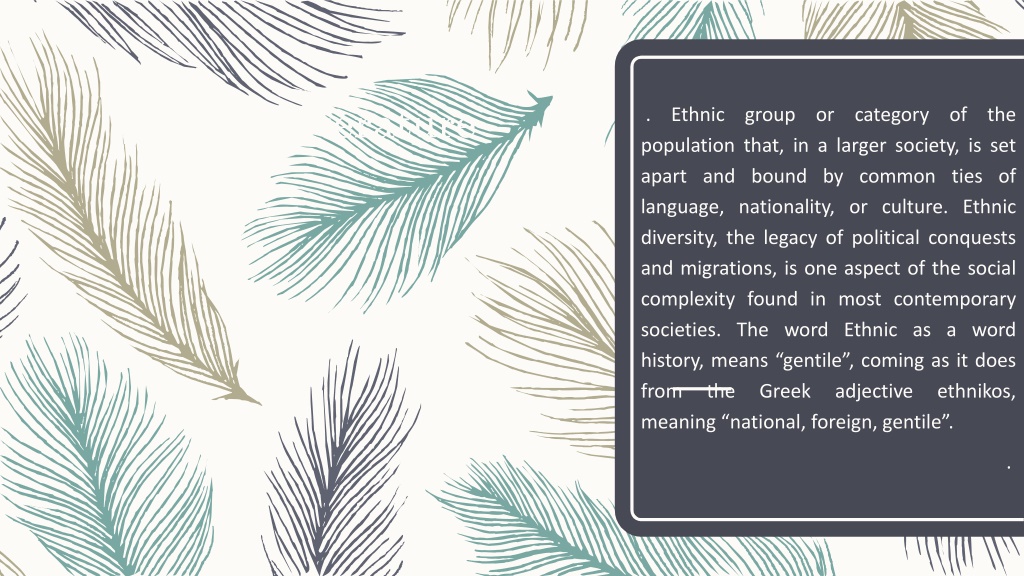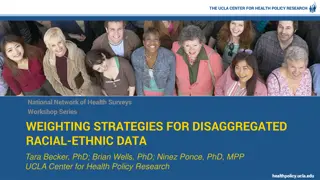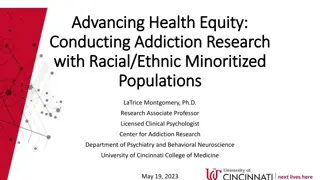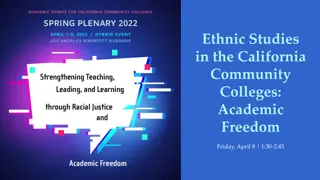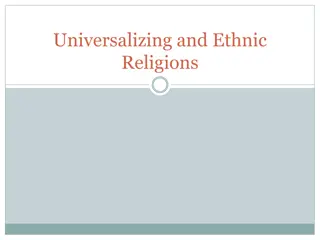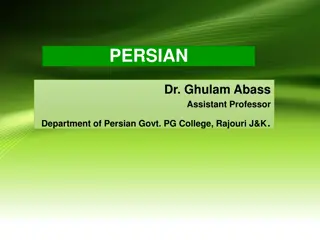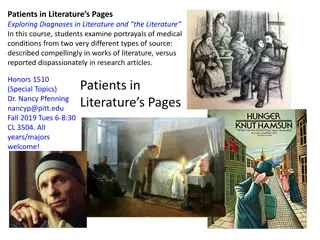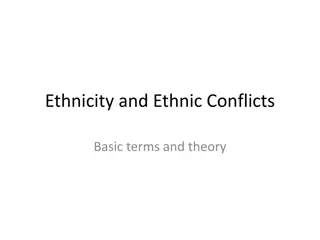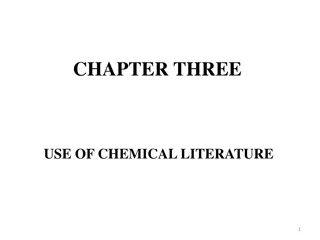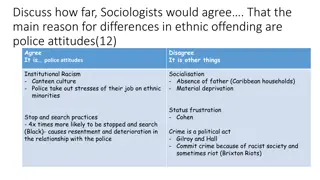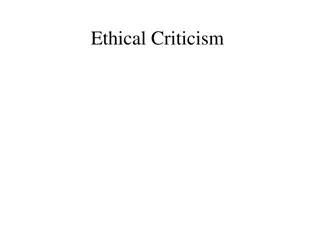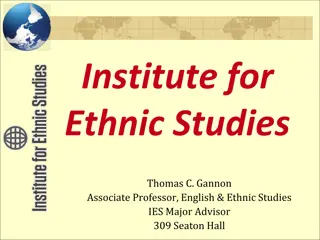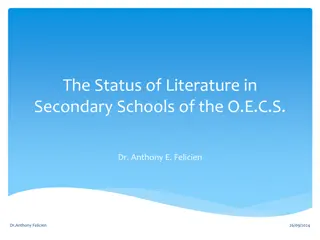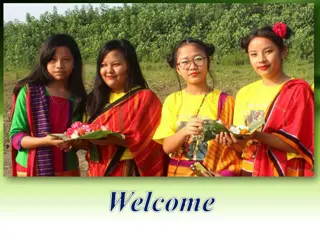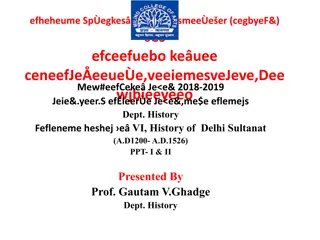Understanding Ethnic Literature
Ethnic literature focuses on the unique cultural identities of different ethnic groups within society, shaped by language, nationality, heritage, and customs. It explores how ethnicity influences social dynamics, discrimination, and group formation. Social sciences and psychology delve into the complexities of ethnic identity, belongingness, and group valuation. The narrative also reflects on the mobility and transformation of identities within devalued and valued ethnic groups, especially highlighting the experiences of people of color in the United States.
Download Presentation

Please find below an Image/Link to download the presentation.
The content on the website is provided AS IS for your information and personal use only. It may not be sold, licensed, or shared on other websites without obtaining consent from the author. Download presentation by click this link. If you encounter any issues during the download, it is possible that the publisher has removed the file from their server.
E N D
Presentation Transcript
Ethnic Literature . Ethnic group or category of the population that, in a larger society, is set apart and bound by common ties of language, nationality, or culture. Ethnic diversity, the legacy of political conquests and migrations, is one aspect of the social complexity found in most contemporary societies. The word Ethnic as a word history, means gentile , coming as it does from the Greek meaning national, foreign, gentile . adjective ethnikos, .
Ethnic Literature Ethnicity has been defined as a group within a larger society which considers itself to be different or is considered by the majority group to be different because of its distinctive ancestry, culture and customs. Ethnicity in a group generally becomes pronounced as a result of migration (forced or voluntary), and a group may only achieve the status of an ethnic association as a result of migration. Ethnicity is often the basis for social discrimination in which ethnic unity tends to increase as a result of such discrimination. Furthermore, the ethnic group is a group of humans, whose members identify with each other, through a common heritage that is real or assumed-sharing cultural characteristics. This heritage bases on common ancestry, history, kinship, religion, language, shared territory, nationality or physical appearance.
Ethnic Literature In social sciences, however, the usage has become more generalized to all human groups that explicitly regard themselves and are regarded by others as culturally distinctive. Among the first to bring the term ethnic group into social studies was the German sociologist Max Weber, who defined it as: Those human groups that entertain a subjective belief in their common descent because of similarities of physical type or of customs or both, or because of memories of colonization and migration; this belief must be important for group formation; furthermore, it does not matter whether an objective blood relationship exists
Ethnic Literature social psychologists center their concern in exploring the feeling of belonging to a group and the consequences of identification with one s social groups in society. Those social psychologists have focused on the negotiation of one s social identity in the broader context of the value society has placed on one s group membership. They assert that individuals who belong to highly valued groups do not need to modify or enhance their social identity; however, when faced with a behavior of devaluating a group, the person may have to engage in another group of high value.
Ethnic Literature One can notice that the matter of mobility and changing identity from a devalued group to valued, could be a result of one of the three: (a) individual mobility in which man chooses physically to leave his group and be with another one, (b) social creativity the group as a whole chooses to redefine the meaning of their group by comparing themselves with a superior group as changing from negative to positive. (c) Social competition- in which the group as a whole fights the current system to actually change the hierarchy of group membership in society. Relatively to people of color in the United States, such a group is generally considered members of devaluated group held in low regard by society that affected them negatively.
Ethnic Literature Common ethnicity as a psychological reality constituting a community is now understood as a cultural attribute that ties some aspects as language, religion, social rituals and routines, with their feeling of togetherness. During the 1970 s and 1980 s, various demographic trends, such as increased immigration from Asia and Mexico, helped the United States become much more multicultural, and more Asian American writers felt encouraged to explore Asian themes. Although Asia is a large continent with many languages, cultures, and religions, certain themes and elements appear to be common in Asian American literature. These include the balance between dark and light and between masculine and feminine; conflicts between ancient heritage, familial obligations, and contemporary (often Western) lifestyles; and the effects of immigration.
Ethnic Literature Hybridity, a major theme in postcolonial literature Having dealt with the theme of gender (in a limited scope). In essence, hybridity is an every-day reality that we encounter in an increasingly multi-ethnic and pluralistic society. Common heritage of most of the Asian and African nations is that the heritage of colonialism. Colonialism, without doubt, is an encounter between cultures, languages, people and system of thought within the ambit( zone) in which the power is vested with the white colonial masters. Colonial administration in Asian, African and South American regions infused European form of thinking, European languages, culture, education and way of life
Ethnic Literature Hybridity is a creation of a new cultural forms and realities resulting from colonial encounter. In colonial societies, Hybridity may be in the form of the revival of the pre-colonial past. This can be in either reviving folk or tribal cultural forms or conventions or adapting contemporary artistic and social productions to suit the present-day conditions of globalization, multiculturalism and transnationalism.
Sui Sin Far 1865-1914 Sui Sin Far 1865 -1914 (Born Edith Maude Eaton; wrote under the pseudonyms Sui Sin Far, Sui Seen Far. Canadian short story writer, journalist, and essayist. Sui Sin Far is regarded as the first fiction writer of Asian descent to achieve professional publication in the Americas. The child of a British father and part-Chinese mother, Far's stories focus on the experiences of Chinese immigrants to the United States and Canada. In her short stories, Far countered popular stereotypes of Chinese immigrants and spoke against racial prejudice. She frequently focused on the unique position of Eurasians like herself, of mixed Western and Asian descent, who are often excluded from both Anglo and Asian communities. Far published numerous short stories, sketches, essays, and articles in popular magazines throughout the United States.
Sui Sin Far 1865-1914 Mrs. Spring Fragrance (1912), a collection of short stories, was Far's only volume of fiction to be published during her lifetime. Although somewhat recognized as a noteworthy writer, Far's work was largely ignored by critics from the time of her death until the 1980s, when the burgeoning (flourishing) field of Asian American studies led to a resurgence of critical interest in her work. Her work has been made available to a modern readership with the 1995 publication of Mrs. Spring Fragrance and Other Writings, a compilation of Far's stories, sketches, and essays. Far was born in England, in 1865. Her mother was raised and educated in Britain and was working in China as a missionary when she met Far's father, a British merchant. The family moved from Britain to the United States and, later, to Canada. Far grew up in Montreal, the eldest daughter of a family comprising fourteen children. Far and her siblings, who never learned to speak Chinese, encountered various forms of prejudice within the Chinese immigrant community as well as in mainstream culture.
Sui Sin Far 1865-1914 Far's autobiographical essay Leaves from the Mental Portfolio of an Eurasian describes the uniquely complex status of bicultural Asians residing (living) in both Asian communities and mainstream American society. Far chose never to wed, believing that her identity made marriage to her with either an Anglo or an Asian man undesirable. Far's body of fiction comprises (includes) some forty short stories. The contents of her short story collection Mrs. Spring Fragrance are divided into two sections, Mrs. Spring Fragrance, and Tales of Chinese Children. In both sections, Far depicts the inhabitants of various Chinese communities throughout the United States and Canada, who are simply striving for basic comfort and security while contending with societal challenges. Far's recurring themes include the Chinese immigrant experience, assimilation, interracial marriage and children, cultural conflict, and racism.
Sui Sin Far 1865-1914 In the title story, Mr. Spring Fragrance struggles with the fact that his wife, Mrs. Spring Fragrance, has become thoroughly Americanized. While both husband and wife wear Western clothes, speak English, and live in a Western-style household, Mrs. Spring Fragrance has become assimilated as well to American individualism, while her husband wishes to maintain traditional Chinese notions of marriage and family. Far also wrote of the Chinese immigrant experience in the United States and of such laws as the Chinese Exclusion Act that limited Chinese immigration quotas (portions). In the ironically titled In the Land of the Free, United States immigration officials take away the young son of a Chinese American woman because the child was born in China. The mother spends ten months and all of her money on legal action pleading with the Great Government at Washington to return her son. When he is finally returned, she is completely impoverished (penniless) and he has become so assimilated to American culture that he scorns her and fails to acknowledge her as his mother.
Mrs. Spring Fragrance During the time Eaton wrote the stories that make up Mrs. Spring Fragrance, racist US policies were targeting Chinese immigrants. The federal government passed the Page Act in 1875, which banned Chinese women from immigrating to the United States. In 1882, the Chinese Exclusion Act prohibited all Chinese laborers from immigrating. In 1892, passage of the Geary Act made it a requirement for Chinese immigrants to carry identification cards to prove they were in the country legally, or they could face deportation. Chinese immigrants rallied against what they called the Dog Tag Law in a large-scale act of civil disobedience. They filed over 7,000 lawsuits challenging the Chinese Exclusion Act, which the government eventually repealed in 1943.
Mrs. Spring Fragrance Eaton centers most of her stories around marriage and family dynamics. From the 1840s throughout the years she wrote the stories, the women s suffrage movement was gaining strength in the United States. The changing roles of women in American society had a direct impact on the marriages and family structures outlined in this collection. Not only are many of the characters navigating a culture new to them, but that culture itself is undergoing massive changes as the movement toward social reform and women s rights moves forward. It was only eight years after the publishing of Mrs. Spring Fragrance that women got the right to vote.
Mrs. Spring Fragrance Some of these same themes are highlighted in Mrs. Spring Fragrance in the form of slice-of-life stories that take place in Seattle and San Francisco, both of which were hotbeds for Chinese immigration. At the surface, the family fables seem charming, sweet and simple, but any reader who is aware of the historical and social context of her work will have a fuller appreciation for Eaton s real mission.
Mrs. Spring Fragrance The ironically-titled In the Land of the Free highlights the suffering faced by racially discriminatory immigration laws such as the Chinese Exclusion Act of 1882 (and later, 1892 and 1902, which prohibited all immigration of Chinese laborers the first time a specific ethnic group was targeted) and the suffering of a Chinese woman whose baby is taken away by U.S. government officials for a full year. At the time, Chinese women in America were few and far between (again, thanks to discriminatory immigration laws) and if they were present in popular culture, they were represented as prostitutes, sing-song girls or opium den smokers. For Eaton to characterize a Chinese woman as a loving mother torn apart by her son s tragic absence was downright (absolutely) revolutionary.
Mrs. Spring Fragrance A common theme in many of Eaton s short stories is her defense and promotion of the independent woman (it s important to note that Eaton herself never married, also a revolutionary act at the time). Stories such as The Americanization of Pau Tsu and Mrs. Spring Fragrance tackle the issue of cultural assimilation while The Story of One White Woman Who Married a Chinese and Her Chinese Husband deals with interracial marriage, identity and, heartbreakingly, racial violence. Eaton also shines a light on gender issues within Chinese culture, from China s policy at the time of only educating boys to women routinely taking their meals after their husbands (or at a separate table) to men taking secondary wives back home.
